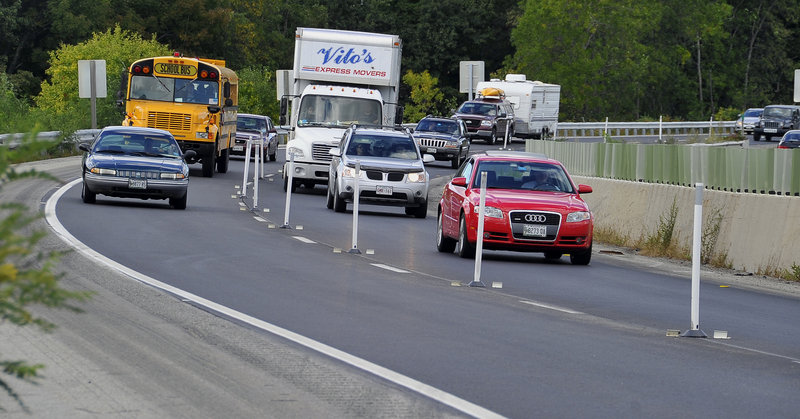Approaching Portland from the north on Interstate 295, motorists have to be sharp.
Amid the curves heading into the city, a line of white posts suddenly appears, creating a tangible barrier between the passing and travel lanes. They’re called delineators and their purpose is to make sure traffic is committed to the left or right before arriving at the barriers protecting workers in the center of the highway on Tukey’s Bridge.
Signs — for the motorists who read them — warn of the approaching center-lane closure, one of 18 bridge repair projects under way this summer on the stretch of highway between Falmouth and Scarborough.
But for some drivers, the signs are not enough.
On Friday, a woman driving her boyfriend to the Portland International Jetport found herself in the passing lane and in danger of missing her exit. She clipped one of the posts and swerved back into her lane, losing control and ending up in the median.
Earlier this week, Stephen Sutmire, who was visiting Maine from Pennsylvania, swerved to avoid one of the posts and rolled the camper he was towing onto the median guardrail, destroying the camper and stalling traffic.
Nobody was injured in either crash.
Several of the plastic delineators have been knocked off their weighted bases, suggesting other cars have gotten out of line.
But for the most part the devices, which are new to Maine, seem to be doing their job.
“We’ve had accidents as a result of people trying to avoid them,” said state police Trooper George Loder, who patrols that section of highway. “Considering the amount of work they’re doing there, I don’t know that I would call it a spike in crashes.”
The Maine Department of Transportation is winding up an ambitious construction season on the state’s busiest road in its biggest city.
A $12.2 million project covering 11.5 miles from Falmouth to Scarborough includes repairing and resurfacing 18 bridges and other improvements.
On the northbound side, an $8.4 million project covers paving improvements on 12 miles from the Portland-Falmouth border to Freeport.
Much of the work won’t be done by the time cold weather shuts down the projects.
The extent of repairs needed on the road wasn’t apparent until the pavement had been stripped off and the underlying concrete exposed, said Brad Foley, highway program manager for the MDOT. And because the paving is being done at night, it can only be done in short stretches, he said.
The result is that much of the work will have to be completed next year, which could have an impact on the bridge and paving work already scheduled. As it is, the state will revisit the construction on northbound bridges and may try to tackle only half as many as it did this summer. Both changes could affect the cost, though it’s not clear how much, Foley said.
The delineators used in the roadway are white to replicate the color of the striping where they are placed, while the ones used on the side of the road are yellow.
The MDOT is planning on installing some of the posts on the raised island separating lanes on the Western Avenue entrance ramp to Interstate 295 north in South Portland.
“It’s definitely become a tricky piece of driving, but I think it’s fine,” said Nicholas Walsh, an attorney who commutes to Portland from Yarmouth, on the sections of highway where the delineators have been used. “I’ve actually looked at it with a significant amount of interest.”
Walsh said the signs do a good job alerting motorists and the workers appear safe behind concrete “Jersey barriers.”
“It’s well-conceived if you’re going to try to accomplish work in the middle of an interstate highway,” he said.
Staff Writer David Hench can be contacted at 791-6327 or at: dhench@pressherald.com
Copy the Story Link
Send questions/comments to the editors.



Success. Please wait for the page to reload. If the page does not reload within 5 seconds, please refresh the page.
Enter your email and password to access comments.
Hi, to comment on stories you must . This profile is in addition to your subscription and website login.
Already have a commenting profile? .
Invalid username/password.
Please check your email to confirm and complete your registration.
Only subscribers are eligible to post comments. Please subscribe or login first for digital access. Here’s why.
Use the form below to reset your password. When you've submitted your account email, we will send an email with a reset code.